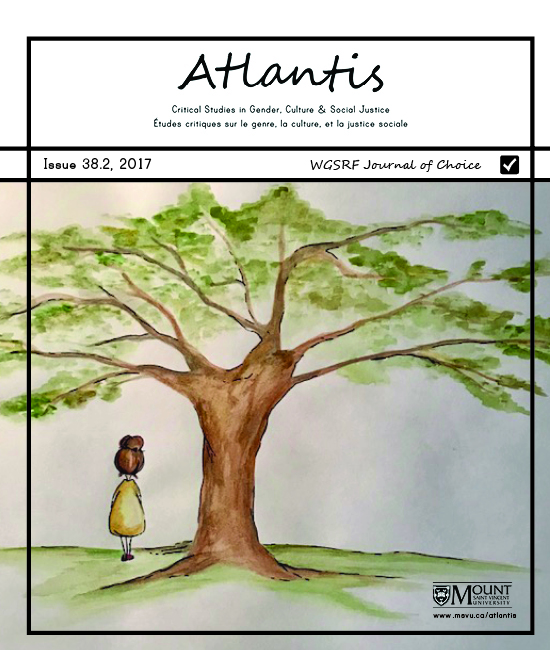Touch and Affect in Alice Munro’s “Nettles”; or, Redefining Intimacy
Keywords:
Intimacy, Skin, TraumaAbstract
Abstract
The skin, and the sense of touch it is linked with, is often an essential way to approach the world in Munro’s stories, and brings the focus onto affects. This study focuses on touch and the skin in “Nettles” (Hateship, Friendship, Courtship, Loveship, Marriage, 2001), a particularly luminous instance of story in which skin and affect together play a key role in creating a sense of intimacy.
Résumé
La peau, et le sens du toucher auquel elle est liée, est souvent un moyen essentiel d’aborder le monde dans les histoires de Munro, et met l’accent sur les affects. Cette étude porte sur le toucher et la peau dans « Nettles » (Hateship, Friendship, Courtship, Loveship, Marriage, 2001), exemple particulièrement lumineux d’une histoire dans laquelle la peau et l’affect jouent un rôle clé dans la création d’un sentiment d’intimité.
Metrics
References
Abraham, Nicolas. 1968. “L’écorce et le noyau.” In L’écorce et le noyau, by Nicolas Abraham and Maria Torok, 203-26. Paris, FR: Flammarion, 2001.
Ahmed, Sara. 2006a. Queer Phenomenology: Orientations, Objects, Others. Durham, NC: Duke University Press.
____. 2006b. “Orientations: Towards a Queer Phenomenology.” GLQ: A Journal of Lesbian and Gay Studies 12 (4): 543-574.
____. 2010. The Promise of Happiness. Durham, NC: Duke University Press.
Ahmed, Sara, and Jackie Stacey, eds. 2001. Thinking Through the Skin. London, UK: Routledge.
Anzieu, Didier. 1985. Le Moi-Peau. Edited by Évelyne Séchaud. Paris, FR: Dunod, 1995.
____. 1994. Le Penser: Du Moi-Peau au Moi-Pensant. Paris, FR: Dunod.
Barthes, Roland. 2002. Le Neutre. Cours Au Collège de France (1977-1978). Edited by Thomas Clerc. Paris, FR: Seuil / IMEC.
Berlant, Lauren. 1998. “Intimacy: A Special Issue.” Critical Inquiry 24 (2): 281-288.
____. 2011. Cruel Optimism. Durham, NC: Duke University Press.
Bigot, Corinne. 2009. “Images du silence dans ‘Vandals’ et ‘Nettles’ d’Alice Munro.” In Pratiques de la trangression dans la littérature et les arts visuels, edited by Héliane Ventura and Philippe Mottet, 169-181. Québec, QC: Éditions de l’Instant même.
____. 2014. Alice Munro: les silences de la nouvelle. Rennes, FR: Presses universitaires de Rennes.
Cox, Ailsa. 2004. Alice Munro. Tavistock, UK: Northcote House.
De Falco, Amelia. 2012. “Caregivers/Caretakers: Economies of Affection in Alice Munro.” Twentieth-Century Literature 58 (3): 377-398.
____. 2016. Imagining Care: Responsibility, Dependency, and Canadian Literature. Toronto, ON: University of Toronto Press.
Gallop, Jane. 1988. Thinking Through the Body. New York, NY: Columbia University Press.
Garber, Marjorie. 2004. “Compassion.” In Compassion: The Culture and Politics of an Emotion, edited by Lauren Berlant, 15-27. London, UK: Routledge.
Hardt, Michael. 2007. “Foreword: What Affects Are Good For.” In The Affective Turn: Theorizing the Social, edited by Patricia Ticineto Clough, ix–xiii. Durham, NC: Duke University Press.
Heble, Ajay. 1994. The Tumble of Reason: Alice Munro’s Discourse of Absence. Toronto, ON: University of Toronto Press.
Howells, Coral Ann. 1998. Alice Munro. Manchester, UK: Manchester University Press.
Munro, Alice. 1982. The Moons of Jupiter. Toronto, ON: Penguin.
____. 2001. Hateship, Friendship, Courtship, Loveship, Marriage. London, UK: Vintage.
Narduzzi, Dilia. 2013. “Regulating Affect and Reproducing Norm: Alice Munro’s ‘Child Play’.” Journal of Literary and Cultural Disability Studies 7 (1): 71-88.
Ngai, Sianne. 2005. Ugly Feelings. Cambridge, MA: Harvard University Press.
Shildrick, Margrit. 2001. “‘You are there, like my skin’: Reconfiguring Relational Economies.” In Thinking Through the Skin, edited by Sara Ahmed and Jackie Stacey, 52-68. London, UK: Routledge.
Spinoza, Baruch. 2002. Complete Works. Translated by Samuel Shirley. Indianapolis, IN: Hackett.
Downloads
Published
Issue
Section
License
Authors who publish with this journal agree to the following terms:
1. Authors retain copyright and grant the journal right of first publication, with the work simultaneously licensed under a Creative Commons Attribution 4.0 International License that allows others to share the work with an acknowledgement of the work's authorship and initial publication in this journal.
2. Authors are aware that articles published in Atlantis are indexed and made available through various scholarly and professional search tools, including but not limited to Erudit.
3. Authors are able to enter into separate, additional contractual arrangements for the non-exclusive distribution of the journal's published version of the work (e.g., post it to an institutional repository or publish it in a book), with an acknowledgement of its initial publication in this journal.
4. Authors are permitted and encouraged to preprint their work, that is, post their work online (e.g., in institutional repositories or on their website) prior to and during the submission process. This can lead to productive exchanges, as well as earlier and greater citation of published work. Read more on preprints here.






